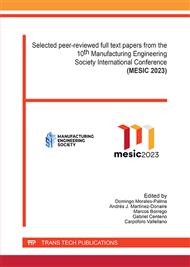p.279
p.289
p.299
p.310
p.320
p.330
p.341
p.353
p.363
Data Preparing for Reverse Engineering
Abstract:
Reverse engineering, or the creation of models from physical objects, is increasingly being used in many industries including manufacturing, automotive design, and computer animation. The presented work focuses on the issue of data preparation for reverse engineering. The aim of the thesis is to map the issues of working with the Zeiss LineScan optical sensor on a 3D coordinate measuring machine in the metrology laboratory of the Regional Institute of Technology at the University of West Bohemia. The aim of the work was to map the software setting options supplied by the sensor manufacturer. The sensor can obtain clouds of three types of points: RSL (Raw Scan Lines - measured points, directly recorded by the scanner, without further adjustments), GSL (Gridded Scan Lines - points reduced and grouped into a grid of a given step), and QSP (Qualified Surface points - compressed and grouped points into a given grid). The evaluation of the experiment revealed the ideal setting for the specified measurement conditions. Reference objects with nominal lengths of 100 mm and 500 mm were chosen. The data required for evaluating each sensor setting were obtained through a series of measurements of these objects. The output of the experiment is a comparison of each option for setting up the scanning method. GSL points with a step setting of 0.1 mm were evaluated as the most suitable setting for measuring objects with similar shapes. They showed stable deviations within the selected tolerance of ± 0.03 mm for all measurement variations. RSL and QSP points, on the other hand, showed less stability of deviations across the measurements.
Info:
Periodical:
Pages:
320-329
Citation:
Online since:
October 2023
Authors:
Price:
Сopyright:
© 2023 Trans Tech Publications Ltd. All Rights Reserved
Share:
Citation:



